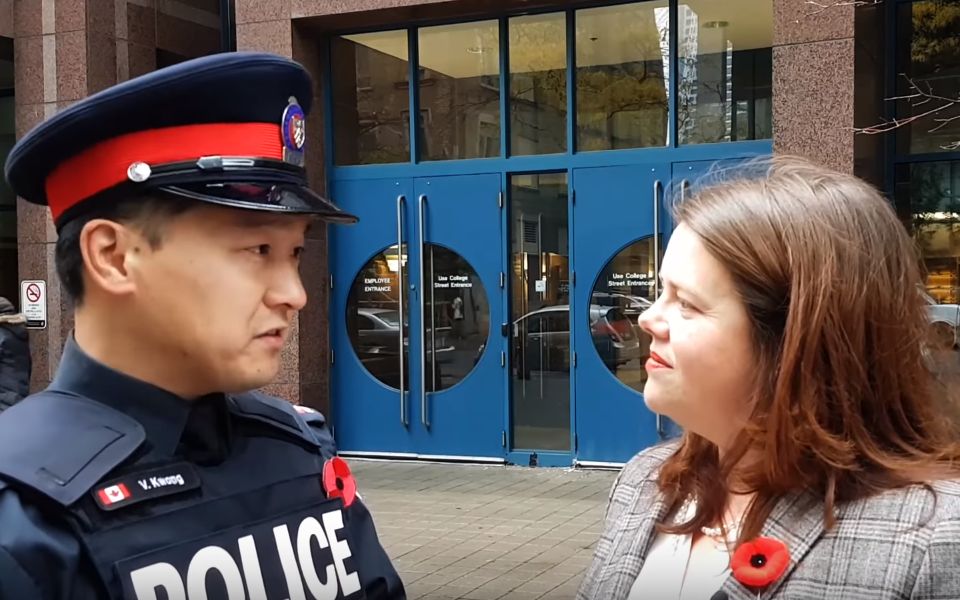
When the Toronto Police Service (TPS) announced it would stream daily “newscasts” starting in November in what it called an attempt to share its view of crime in the city, some journalists said it was an attempt to restrict the flow of public information.
The broadcasts feature TPS constables and civilian staff reading scripts earnestly, if awkwardly, in front of a camera for five minutes. In one newscast, a police officer delivers her script in front of stacks of boxes, later revealed to be cold case files. In another, a little boy who happened to be walking by joins the day’s anchor in a standup on a Toronto residential street.
Two months later, little about how Toronto police communicate with media appears to have changed. However, the move is part of a trend in the relationship between cops and journalists in Canada, set in motion by the rise of social media, says Chris Schneider, a professor at Brandon University in Manitoba and author of the book Policing and Social Media.
“Up until very recently, police have had a virtual monopoly on getting to say what crime is,” he says.
“Now the public are commenting on these crimes as they’re happening, sometimes live and in real time. We see a competing crime narrative that quickly unfolds online that is completely outside the control of the police getting to say what the crime is and how it was done.”
Police control over information has, in the past, been a touchy subject for Toronto media. Especially now, with TPS among many forces in North America facing criticism and calls for greater transparency.
Tensions were similarly high in 2015, when TPS joined several forces in southern Ontario in switching to encrypted scanners — cutting off crime reporters from eavesdropping on police transmissions, their main and time-honoured method of newsgathering.
TPS said it would still release information via its Twitter account, but the move would protect the security of operations and privacy of those who call 911 for help. Journalists responded that it would allow police complete control over information, resulting in less transparency, especially in situations where police might be cast in a less-than-flattering light. The change happened anyway.
So when TPS released a promotional video for its new broadcasts at the beginning of November, saying the shows would “correct the record” and provide “unfiltered” information, some were nervous.
“We should be concerned about this,” wrote Beach Metro News editor Anna Killen on Twitter after the promotional video went up online. “Public outreach by police can be good…but a centralized communications outfit worries me.”
In its story about the change, CityTV used the headline “Self-produced Toronto police news show: propaganda or PR?” It quoted former Toronto mayor John Sewell and Ryerson University journalism professor Lisa Taylor, both of whom said dressing up potentially biased information as journalism would be dangerous.
“When we put it out I think some of that language was interpreted in a way that made it seem like we were trying to counter mainstream media rather than, I want to say, complement it almost, which is more what we were trying to do,” says TPS spokesperson Meaghan Gray. “It’s not so much about providing opposite information to the media, it’s more about providing additional information to the media.”
Roughly three months after the five-minute daily shows launched on YouTube, and the minor controversy surrounding the launch, little appears to have changed about crime reporting in Toronto.
“We haven’t changed the way we do business with reporters at all,” says Meaghan Gray. “We still provide the same type of information from the same people at the same time.”
The broadcasts start with a rundown of crime in the city over the past day and end with a feature highlighting a part of the force’s operations. Many items, if they are newsworthy, already appear in the TPS Twitter account or in press releases. The other stories don’t appear to have made headlines beyond the newcasts, which average between 300 and 600 views. Some journalists opposed to the show’s existence haven’t actually encountered it in the newsgathering process so far.
“I shamefully haven’t watched them yet,” Killen told the RRJ in an email, adding that she’d rather not say more until she has time to take a look.
Gray says she remembers blowback at the beginning, but didn’t receive any complaints about it it after the launch. “I haven’t heard anything from reporters or journalists since,” she says.
And so the news cycle in Toronto marches on. However, Schneider says a true test of the TPS broadcasts will come when some inevitable, unfortunate event happens that shows the force in an unflattering light. If the story presented in the police newscasts is the one that sticks in the minds of the public and makes its way into media reports, the YouTube channel will have fulfilled its purpose.
“The Toronto police can always put out their own little release and say, ‘well, (journalists) got it wrong, this is not actually what we meant. (Reporters) took the story and misinterpreted what we meant. Here’s what we meant,’” he says. “It allows the police to regain some control basically over the construction of crime narratives.”
About the author
Emma McIntosh is the digital managing editor for the RRJ for the 2017-18 masthead.